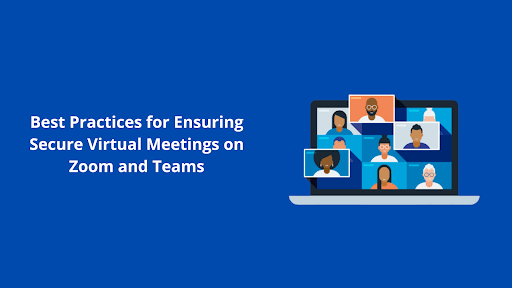Best Practices for Ensuring Secure Virtual Meetings on Zoom and Teams
samanvya August 18, 2023 0 COMMENTS
Both organisations and people now depend on remote work and virtual meetings. Zoom and Microsoft Teams have become two of the most widely used systems for doing online meetings. But these platforms’ simplicity also brings a critical need for security.In this blog we’ll explore the best practices for maintaining safe virtual meetings on both Zoom and Microsoft Teams. Additionally, we will discuss the value of Microsoft Security Certification and compare the capabilities of Zoom Vs Microsoft Teams Security.
Table of Contents
Microsoft Security Certification: A Seal of Trust
It’s important to recognise the relevance of Microsoft Security Certification before getting into the intricacies of secure virtual meetings. Users may be certain that the platform upholds strict security requirements thanks to this accreditation, which serves as a Trustmark. Microsoft’s thorough certification procedures, including the Microsoft 365 Certified: Security Administrator Associate certification, highlight the company’s dedication to security. This certification guarantees that administrators have the abilities needed to safeguard Microsoft 365 corporate settings successfully.
Zoom vs Microsoft Teams Security: A Comparative Analysis
Zoom and Microsoft Teams provide a wide range of tools for virtual meetings. They provide varying degrees of security, though. When Zoom first encountered security issues, the firm strengthened its security procedures. While Zoom has made progress in resolving these concerns, Microsoft Teams stands out for its integration with the strong security architecture of Microsoft 365.
Best Practices for Secure Virtual Meetings
Let’s now go into the recommended practises for using Microsoft Teams and Zoom that will help you conduct your virtual meetings safely:
- To prevent unauthorised access, use two-factor authentication (2FA). This additional layer of protection verifies the user’s identification, improving meeting security overall.
- To guarantee you receive the most recent security updates, often update your Microsoft Teams and Zoom programs. Hackers frequently target weaknesses in out-of-date software.
- Create distinctive meeting IDs and distribute them over secure means. A personal meeting ID should be used sparingly since this raises the possibility of unauthorised access.
- Only the hosts and selected presenters may share their screens. This stops inappropriate material from being shown during the conference.
- Utilise the waiting areas to screen visitors before allowing them admission. This keeps unexpected visitors away.
- For your meetings, give preference to solutions that provide end-to-end encryption. As a result, the meeting’s content can only be accessed by attendees who have the encryption key.
- Disable file transfers during meetings to stop the distribution of harmful materials. As a result, there is a lower chance of viruses propagating via shared files.
- Give attendees instructions on safe meeting procedures. Inform them of the significance of not posting meeting IDs or URLs on open forums.
Zoom’s Encryption Approach
Data transmission between participants is safe with Zoom’s AES 256-bit encryption. It’s important to remember that Zoom’s encryption was end-to-end by default in April 2020. The security of the platform was questioned in light of this. In response, Zoom implemented end-to-end encryption for all meetings, improving the privacy of conversations and shared information.
Microsoft Teams’ Advanced Encryption
Integrating Microsoft Teams with the security framework of Microsoft 365 is advantageous. The platform uses encryption not just when data is being transmitted but also when it is being stored and used. Microsoft Teams support the Advanced Encryption Standard (AES) with 256-bit keys. With this degree of encryption, data is protected from being readable by unauthorised parties, even if intercepted.
Conclusion
Virtual meetings must be secure since they are now a fundamental part of modern business culture. Zoom and Microsoft Teams have practical features, but Microsoft Teams stands out for its seamless integration with the firm’s massive security infrastructure. By following the suggested procedures outlined in this article, you may conduct virtual meetings with confidence and safety. Keep in mind that being aware and adopting security procedures will assist.
RELATED ARTICLES
Latest Articles
 Laura Ingraham Husband James Reyes: Why …In BiographyApril 17, 2025Laura Ingraham is a well-known conservative […]
Laura Ingraham Husband James Reyes: Why …In BiographyApril 17, 2025Laura Ingraham is a well-known conservative […] Zach Top Wife Mystery Solved! Meet the W…In BiographyApril 16, 2025Zach Top’s music has that classic country feel that […]
Zach Top Wife Mystery Solved! Meet the W…In BiographyApril 16, 2025Zach Top’s music has that classic country feel that […] What Is a Parcel Locker? The Game-Change…In TechnologyApril 16, 2025Missing packages? Porch pirates? Missed delivery slips […]
What Is a Parcel Locker? The Game-Change…In TechnologyApril 16, 2025Missing packages? Porch pirates? Missed delivery slips […] Dawn Staley Relationship Rumors: What’s …In BiographyApril 15, 2025When it comes to iconic figures in sports, Dawn Staley […]
Dawn Staley Relationship Rumors: What’s …In BiographyApril 15, 2025When it comes to iconic figures in sports, Dawn Staley […] How Window Tinting Affects Driver Visibi…In TechnologyApril 11, 2025Introduction: Beyond Style — The Functional Side of […]
How Window Tinting Affects Driver Visibi…In TechnologyApril 11, 2025Introduction: Beyond Style — The Functional Side of […] Vaishnav Tej Wife, Age, Family, Girlfrie…In BiographyApril 11, 2025Vaishnav Tej wife: There is always more to know about […]
Vaishnav Tej Wife, Age, Family, Girlfrie…In BiographyApril 11, 2025Vaishnav Tej wife: There is always more to know about […] Nick Sandmann Net Worth, Biography, Heig…In BiographyApril 11, 2025Young Nick Sandmann, catapulted into the media […]
Nick Sandmann Net Worth, Biography, Heig…In BiographyApril 11, 2025Young Nick Sandmann, catapulted into the media […] Cold War Timeline: The Real Story Behind…In HistoryApril 4, 2025If you’ve ever wondered how we ended up with the […]
Cold War Timeline: The Real Story Behind…In HistoryApril 4, 2025If you’ve ever wondered how we ended up with the […]
stopie.com is a participant in the Amazon Services LLC Associates Program, an affiliate advertising program designed to provide a means for sites to earn advertising fees by advertising and linking to Amazon.com.
Clicking on an Amazon link from stopie.com does not increase the cost of any item you purchase.
We will only ever link to Amazon products that we think our visitors may be interested in and appreciate learning more about.


